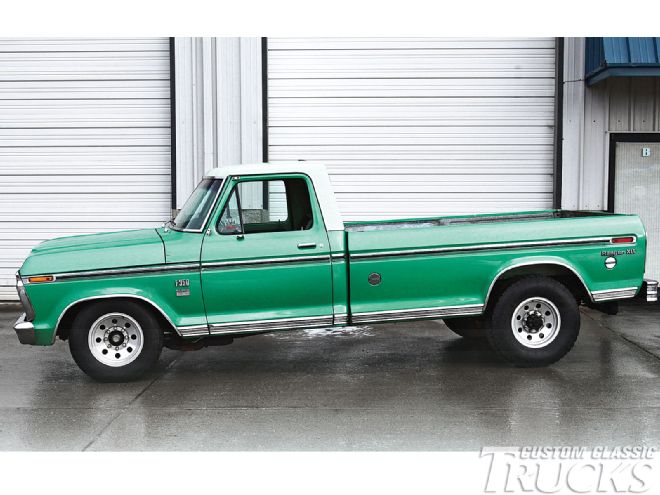
No matter how much planning is done project vehicles seem to establish their own direction. Take our Hot Rod Hauler as an example, we had accomplished many of the original goals—lowering the truck on both ends was one of them-- and now we’re going to redo the rear.
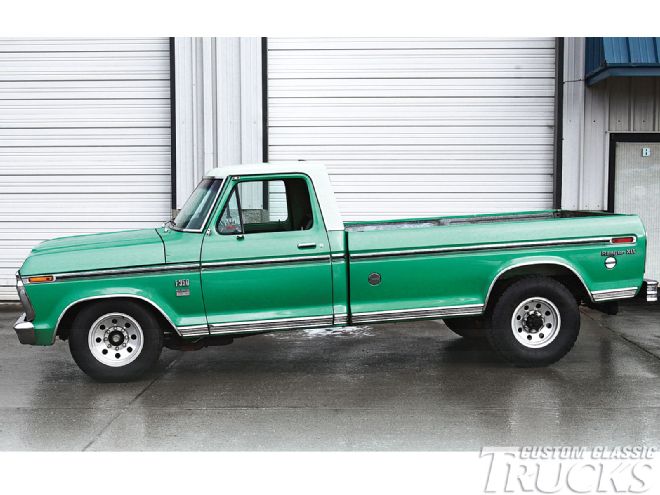 After installing dropped axles the front of our Ford was 3 inches lower up front and had a severe rake, so after this photo was taken we lowered the back the same amount. To make a long story short, we weren’t happy with the results.
After installing dropped axles the front of our Ford was 3 inches lower up front and had a severe rake, so after this photo was taken we lowered the back the same amount. To make a long story short, we weren’t happy with the results.
In stock form, the truck was roughly three inches lower in front than in the rear, but that rake never really bothered us. We installed dropped axles from airbagit.com/Chassis Tech that dropped the front 3 inches and modified the stock rear springs by removing leafs and got the back down roughly the same amount. Unfortunately, when we thought we were done with the suspension, we stood back and took a look at the F-350 and didn’t like what we saw. It still had the nose down stance but for some reason we liked it less than when it was stock and sat at the same angle, and their were other problems as well.
One of the first things we noticed with our modified stock springs was wheel hop on hard acceleration and braking, that was something new and unwanted. In addition, adding the tongue weight of our loaded car trailer caused the springs to flex at an odd angle (no doubt from a lack of support due to the removal of leafs) even with the auxiliary airbags. Now we were concerned about breaking a spring with a load, so we did what we should have done in the first place, we called Mike Eaton. Mike is the man in charge at Eaton Detroit Spring, a company that has been in business since 1937. They have over 24,000 blueprints for OEM springs, and can come up with 166,000 spring combinations. If your needs still aren’t covered there’s an in-house design staff that can create a custom leaf or coil.
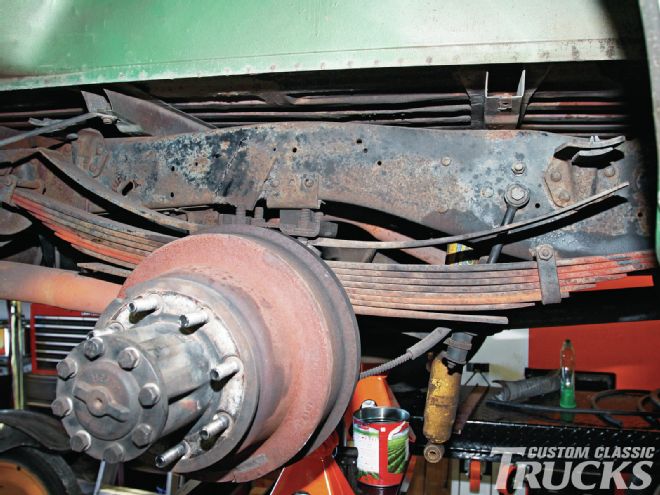 The stock rear springs were extremely stiff which resulted in a rough ride. There were also two overload leafs; Ford took the one-ton rating seriously.
The stock rear springs were extremely stiff which resulted in a rough ride. There were also two overload leafs; Ford took the one-ton rating seriously.
Springs Simplified
It’s said that if something looks simple look again because you’re missing something. That’s certainly true of springs, they’re more complicated than they look, but we’ll rely on excerpts from Mike’s “Spring 101” to explain it all.
By design, leaf and coil springs support the weight of the vehicle, provide cushioning with adequate stability and resistance to side sway and rollover, and resist cornering effects when negotiating a curve. In addition, leaf springs connect the axle to the vehicle, transfer driving and braking forces between frame and axle while resisting “wrap up.”
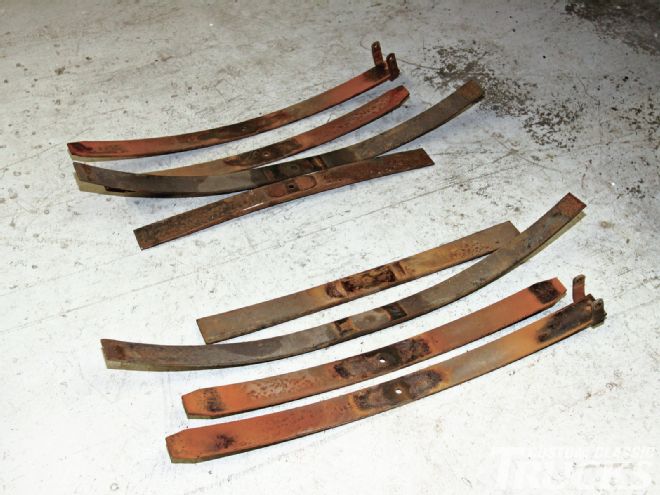 We removed the overloads thinking their thickness would help lower the truck, we also removed two more leafs. The truck did come down the 3 inches we were after, but it wasn’t enough.
We removed the overloads thinking their thickness would help lower the truck, we also removed two more leafs. The truck did come down the 3 inches we were after, but it wasn’t enough.
Quality springs are made from high alloy spring steel known as SAE-5160. Good springs have a memory that allows them to return to the original position time after time. And while it is true that over time springs will settle and lose their ability to support weight, springs made from SAE-5160 will outlast the others many, many, times over offsetting any cost savings.
Spring Rate vs. Load Rate
While these two terms sound similar they are not the same. Spring rate can be simply stated as the amount of weight required to deflect a spring (any spring) one inch. The lower the rate, the softer the spring. The softer the spring the smoother the ride.
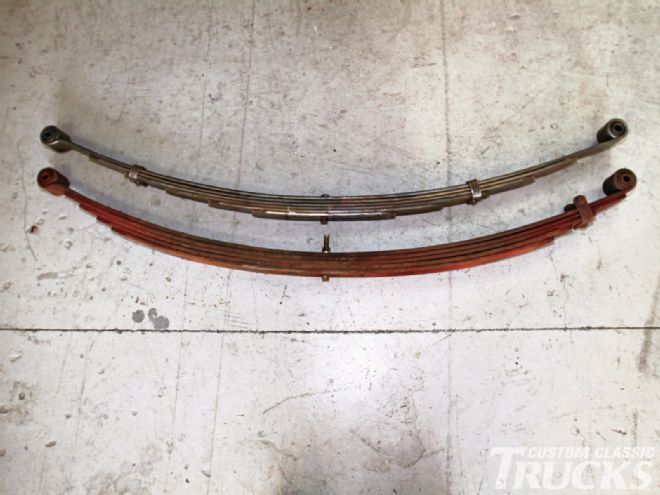 We finally wised up and ordered a pair of custom springs from Eaton Detroit Spring. Although the free arch arc of the replacement (top) is about the same as the stocker (bottom) the new spring with thinner leafs is engineered to provide the drop we were after.
We finally wised up and ordered a pair of custom springs from Eaton Detroit Spring. Although the free arch arc of the replacement (top) is about the same as the stocker (bottom) the new spring with thinner leafs is engineered to provide the drop we were after.
Load rate is the amount of weight a spring is designed to carry when it is deflected to a certain height. A better term would be rated load or, better yet, the term we use, design load. In many cases the design load has nothing to do with how much weight the spring will really be carrying. Design load is a number chosen by the spring engineer and is the amount of weight that is really on the spring. An example of all of this would be a leaf spring that has a free arch of 6 inches, a rate of 200 pounds and is designed to carry 600 pounds when it is deflected to 3 inches, but is only carrying 400 pounds. The correct way to describe this leaf spring would be: Rate is 200 pounds–Load Rate or Design Load is 600 pounds–Load of 400 pounds.
All of the above terms apply to all springs, leaf, coil, steel, rubber and air.
The Three Types of Leaf Springs
Multi-Leaf springs consist of heat-treated flat steel bars of diminishing lengths formed to a predetermined arch held together by a bolt through its center.
Mono-Leaf springs consist of only one heat-treated plate of steel whose thickness is uniformly tapered from the center to each end. A tapered mono-leaf spring can equal or exceed the strength of a multi-leaf spring.
Parabolic springs are multi-leaf versions of Mono-Leaf springs. That is, they consist of 2 or more full tapered leaves.
Spring Eyes
Leaf spring eyes hold the bushings through which bolts or pins pass through to attach the spring to the vehicle. Spring eyes can be standard, Berlin or reverse and each has advantages.
Standard eyes are the most popular and easiest to make. Main plates (commonly called the main leaf) with standard eyes can receive additional support by extending the second leaf or a wrap plate.
Berlin eyes places the load through the centerline of the main pate, which reduces lateral deflection.
Reverse eyes will lower a vehicle while providing maximum spring travel.
The disadvantage of Berlin and Reverse eyes is that they cannot be provided additional support from the second leaf. However, this may not be required in most cases.
Measuring Springs
As a spring flexes up and down the eye to eye length changes. A 48-inch spring that has a 6-inch arch will measure 46¾ inches eye to eye. With a 3-inch arch the eye-to-eye measurement is 47¾ inches.
The correct way to measure a spring is to measure as though the spring was flat. Following the curve of the spring, measure from the center of the front eye back to the center bolt, then measure from the center bolt back to the center of the other eye again following the curve of the spring. This method will provide for the correct length no matter what the arch of the spring is.
Additionally, because the axle location is determined by the location of the spring center bolt, measuring this way provides for accurate axle positioning.
Measuring Free Arch
Free arch is how much arch is in a leaf spring when there is no load on the spring. To check the free arch draw a line through the center of the spring eyes. Then measure from that line to the top of the main plate (the leaf with the eyes) next to the center bolt. (C in the above diagram)
The Making of a Good Leaf Spring Suspension
Achieving a smooth, nice riding and handling leaf spring suspended vehicle is very simple, provided some basic rules are followed.
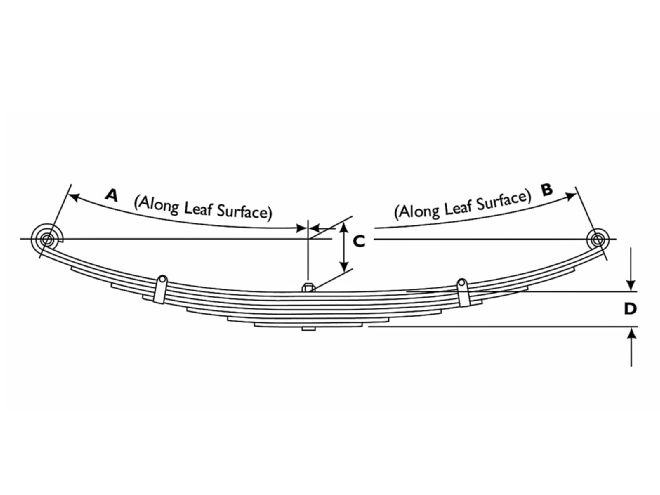 To get the proper replacement springs requires correct measurements—the wrong way to do it is simply measure eye to eye.
To get the proper replacement springs requires correct measurements—the wrong way to do it is simply measure eye to eye.
1) Multi-leaf springs: Only with multi-leaf springs can the correct spring design be achieved. Springs support weight, absorb road shock and set vehicle height. With multi-leaf springs, critical design factors such as stepping, rate, load, and spring height can be fine-tuned.
2) End type: Square ends, or constant thickness ends are great for trucks, while diamond pointed or trimmed ends will improve ride quality.
However, for the smoothest riding spring, the ends must be tapered.
Tapered leaf ends move the friction area away from the leaf ends and spread it over a much larger area, resulting in less force needed to flex the spring.
3) Blocks: The use of blocks to either lower or raise a vehicle is the leading cause of axle windup and poor vehicle handling. The most secure suspension is one where an imaginary line drawn between the spring eyes is as close to the axle seat as possible. The use of blocks takes this line away from the axle seat resulting in a fulcrum point. This leverage point allows the axle to pivot around the spring seat causing axle windup and handling problems.
4) Shackle angle: As a spring flexes, it grows in length. The purpose of a shackle is to allow for this growth. Although spring rates are fixed by its makeup, the amount of force required to move a spring can be greatly increased by incorrect shackle angle. Any shackle angle exceeding 15 degrees is too great.
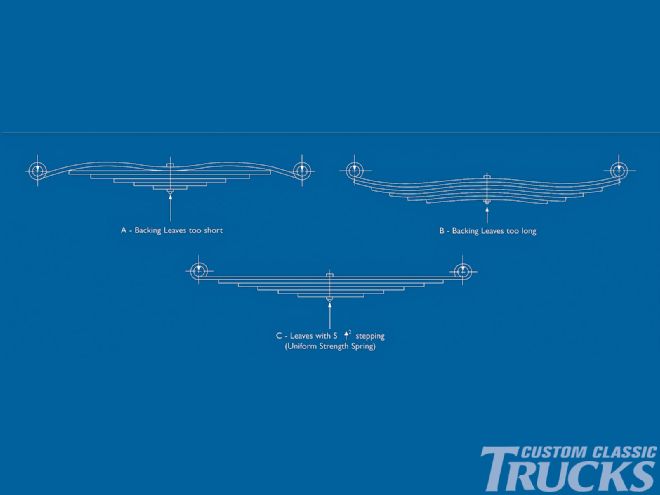 Springs will deform for a variety of reasons, including removing leafs like we did.
Springs will deform for a variety of reasons, including removing leafs like we did.
What’s Next for the Hot Rod Hauler?
Originally, we dropped the rear of the Hot Rod Hauler 3 inches by modifying the stock springs, and that left us just enough room between the axle housing and the framerails for suspension travel. We’ve since installed a proper pair of de-arched springs to lower the truck the same 3 inches as the modified stock springs, plus we’re relocating the spring hangers to drop it another 3 inches. Of course, now we have to modify the framerails for axle clearance—but that’s yet another story. CCT